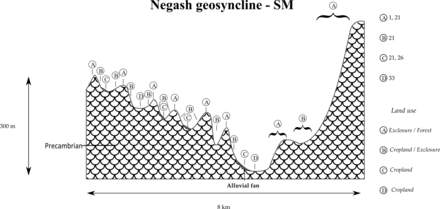Soil in Sa'isi Tsa'ida Imba
The soils of the Sa'isi Tsa'ida Imba woreda (district) in Tigray (Ethiopia) reflect its longstanding agricultural history, highly seasonal rainfall regime, relatively low temperatures, overall dominance of metamorphic and sandstone lithology and steep slopes.[1][2][3]
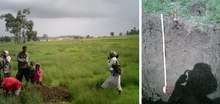
Factors contributing to soil diversity
Climate
Annual rainfall depth is very variable with an average of around 600 mm.[4] Most rains fall during the main rainy season, which typically extends from June to September. Mean temperature in woreda town Freweyni is 18.2 °C, oscillating between average daily minimum of 10.1 °C and maximum of 25.9 °C. The contrasts between day and night air temperatures are much larger than seasonal contrasts.[5]
Geology
From the higher to the lower locations, the following geological formations are present:[6]
Topography
As part of the Ethiopian highlands the land has undergone a rapid tectonic uplift, leading the occurrence of mountain peaks, plateaus, valleys and gorges.
Land use
Generally speaking the level lands and intermediate slopes are occupied by cropland, while there is rangeland and shrubs on the steeper slopes. Remnant forests occur around Orthodox Christian churches and a few inaccessible places. A recent trend is the widespread planting of eucalyptus trees.
Geomorphic regions and soil units
Given the complex geology and topography of the district, it has been organised into land systems - areas with specific and unique geomorphic and geological characteristics, characterised by a particular soil distribution along the soil catena.[9][10][11] Soil types are classified in line with World Reference Base for Soil Resources and reference made to main characteristics that can be observed in the field.
Idaga Hamus highlands
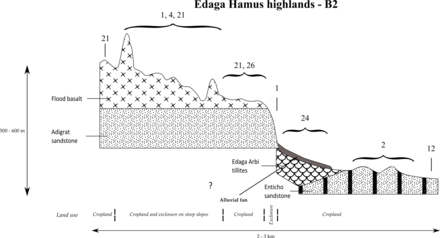
- Associated soil types
- Inclusions
Enticho Sandstone plateau

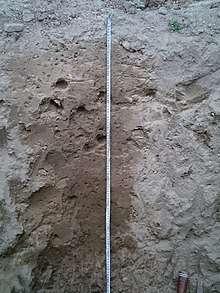
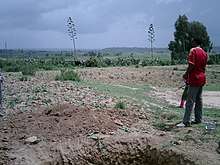
- Associated soil types
- shallow sandy soils with an indurated layer which prevents rooting and drainage (Petric Plinthosol) (9)
- moderately deep, (light) brown, loamy to loamy sandy soil (Chromic Cambisol, Arenic Luvisol, Arenic Lixisol) (28)
- Inclusions
- complex of rock outcrops, very stony and very shallow soils ((Lithic) Leptosol) (1)
- shallow, stony, dark greyish brown clay loams and sandy loams (Eutric Regosol and Cambisol) (21)
- clays of floodplains with very high watertable with moderate to good natural fertility (Eutric Gleysol, Gleyic Cambisol) (33)
Mesa on the Enticho Sandstone plateau

- Associated soil types
- shallow sandy soils with an indurated layer which prevents rooting and drainage (Petric Plinthosol) (9)
- sandy clay loams to sands developed on sandy colluvium (Eutric Arenosol, Regosol, Cambisol) (24)
- moderately deep, (light) brown, loamy to loamy sandy soil (Chromic Cambisol, Arenic Luvisol, Arenic Lixisol) (28)
- Inclusion: complex of rock outcrops, very stony and very shallow soils ((Lithic) Leptosol) (1)
Sinkata plain

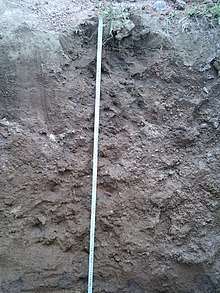
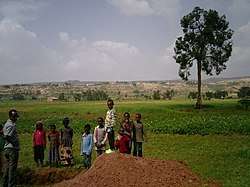
- Associated soil types
- shallow sandy soils with an indurated layer which prevents rooting and drainage (Petric Plinthosol) (9)
- moderately deep, (light) brown, loamy to loamy sandy soil (Chromic Cambisol, Arenic Luvisol, Arenic Lixisol) (28)
- Inclusions
- complex of rock outcrops, very stony and very shallow soils ((Lithic) Leptosol) (1)
- shallow, stony loam soils (Eutric Regosol and Cambisol) (21)
- deep, very hard cracking clays with good natural fertility, waterlogged during the wet season (Mazic (Sodic) Vertisol) (13)
- brown to dark, silty clay loams to loamy sands developed on alluvium, with good natural fertility (Fluvisol) (30)
Suluh plains with metavolcanic rocks
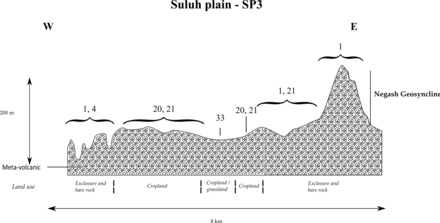
- Associated soil types
- Inclusions
Soil erosion and conservation
The reduced soil protection by vegetation cover, combined with steep slopes and erosive rainfall has led to excessive soil erosion.[7][12][13] Nutrients and organic matter were lost and soil depth was reduced. Hence, soil erosion is an important problem, which results in low crop yields and biomass production.[14] As a response to the strong degradation and thanks to the hard labour of many people in the villages, soil conservation has been carried out on a large scale since the 1980s and especially 1980s; this has curbed rates of soil loss.[15] Measures include the construction of infiltration trenches, stone bunds,[16] check dams,[17] small reservoirs such as Addi Abagiè, as well as a major biological measure: exclosures in order to allow forest regeneration.[18] On the other hand, it remains difficult to convince farmers to carry out measures within the farmland (in situ soil management), such as bed and furrows or zero grazing, as there is a fear for loss of income from the land. Such techniques are however very effective.[19]
References
- Nyssen, Jan; Tielens, Sander; Gebreyohannes, Tesfamichael; Araya, Tigist; Teka, Kassa; Van De Wauw, Johan; Degeyndt, Karen; Descheemaeker, Katrien; Amare, Kassa; Haile, Mitiku; Zenebe, Amanuel; Munro, Neil; Walraevens, Kristine; Gebrehiwot, Kindeya; Poesen, Jean; Frankl, Amaury; Tsegay, Alemtsehay; Deckers, Jozef (2019). "Understanding spatial patterns of soils for sustainable agriculture in northern Ethiopia's tropical mountains". PLoS ONE. 14 (10): e0224041. doi:10.1371/journal.pone.0224041. PMC 6804989. PMID 31639144.
- Tesfu Woldegerima (2006). Soil landscape relationship modelling: A tool for identifying and mapping soils of the watershed (A case study of the midland sandstone dominated soils of Tsenkaniet watershed). Unpub. MSc thesis. Mekelle, Ethiopia: Department of Land Resources Management and Environmental Protection, Mekelle University.
- Hunting Technical Services. Central Tigre Development Study – Tigre Province Ethiopia, Working Paper I: Soils and land classification. Hemel Hempstead (U.K.): Hunting Technical Services Ltd.
- Jacob, M. and colleagues (2013). "Assessing spatio-temporal rainfall variability in a tropical mountain area (Ethiopia) using NOAAs Rainfall Estimates". International Journal of Remote Sensing. 34 (23): 8305–8321. Bibcode:2013IJRS...34.8319J. doi:10.1080/01431161.2013.837230.
- Jacob, M. and colleagues (2019). Dogu'a Tembien's Tropical Mountain Climate. In: Geo-trekking in Ethiopia's Tropical Mountains — The Dogu'a Tembien District. SpringerNature. doi:10.1007/978-3-030-04955-3_3. ISBN 978-3-030-04954-6.
- Sembroni, A.; Molin, P.; Dramis, F. (2019). Regional geology of the Dogu'a Tembien massif. In: Geo-trekking in Ethiopia's Tropical Mountains — The Dogu'a Tembien District. SpringerNature. ISBN 978-3-030-04954-6.
- "Human impact on the environment in the Ethiopian and Eritrean highlands - a state of the art". Earth-Science Reviews. 64 (3–4): 273–320. 2004. doi:10.1016/S0012-8252(03)00078-3.
- Blond, N. and colleagues (2018). "Terrasses alluviales et terrasses agricoles. Première approche des comblements sédimentaires et de leurs aménagements agricoles depuis 5000 av. n. è. à Wakarida (Éthiopie)". Géomorphologie: Relief, Processus, Environnement. 24 (3): 277–300. doi:10.4000/geomorphologie.12258.
- Bui, E.N. (2004). "Soil survey as a knowledge system". Geoderma. 120 (1–2): 17–26. Bibcode:2004Geode.120...17B. doi:10.1016/j.geoderma.2003.07.006.
- "Principes de la cartographie des pédopaysages dans les Alpes". Écologie. 29 (1–2): 49. 1998. ProQuest 223074690.
- Tielens, Sander (2012). Towards a soil map of the Geba catchment using benchmark soils. MSc thesis. Leuven, Belgium: K.U.Leuven.
- Demel Teketay (2001). "Deforestation, wood famine, and environmental degradation in Ethiopia's highland ecosystems: urgent need for action". Northeast African Studies. 8 (1): 53–76. doi:10.1353/nas.2005.0020. JSTOR 41931355.
- Nyssen, Jan; Frankl, Amaury; Zenebe, Amanuel; Deckers, Jozef; Poesen, Jean (2015). "Land management in the northern Ethiopian highlands: local and global perspectives; past, present and future". Land Degradation & Development. 26 (7): 759–794. doi:10.1002/ldr.2336.
- Solomon Hishe, and colleagues (2018). "Analysing past land use land cover change and CA-Markov-based future modelling in the Middle Suluh Valley, Northern Ethiopia". Geocarto International: 1–31. doi:10.1080/10106049.2018.1516241.
- Solomon Hishe, and colleagues (2017). "Soil and water conservation effects on soil properties in the Middle Silluh Valley, northern Ethiopia". International Soil and Water Conservation Research. 5 (3): 231–240. doi:10.1016/j.iswcr.2017.06.005.
- Nyssen, Jan; Poesen, Jean; Gebremichael, Desta; Vancampenhout, Karen; d'Aes, Margo; Yihdego, Gebremedhin; Govers, Gerard; Leirs, Herwig; Moeyersons, Jan; Naudts, Jozef; Haregeweyn, Nigussie; Haile, Mitiku; Deckers, Jozef (2007). "Interdisciplinary on-site evaluation of stone bunds to control soil erosion on cropland in Northern Ethiopia". Soil and Tillage Research. 94 (1): 151–163. doi:10.1016/j.still.2006.07.011. hdl:1854/LU-378900.
- Nyssen, J.; Veyret-Picot, M.; Poesen, J.; Moeyersons, J.; Haile, Mitiku; Deckers, J.; Govers, G. (2004). "The effectiveness of loose rock check dams for gully control in Tigray, Northern Ethiopia". Soil Use and Management. 20: 55–64. doi:10.1111/j.1475-2743.2004.tb00337.x.
- Descheemaeker, K. and colleagues (2006). "Sediment deposition and pedogenesis in exclosures in the Tigray Highlands, Ethiopia". Geoderma. 132 (3–4): 291–314. Bibcode:2006Geode.132..291D. doi:10.1016/j.geoderma.2005.04.027.
- Tewodros Gebreegziabher, and colleagues (2009). "Contour furrows for in situ soil and water conservation, Tigray, Northern Ethiopia". Soil and Tillage Research. 103 (2): 257–264. doi:10.1016/j.still.2008.05.021.
